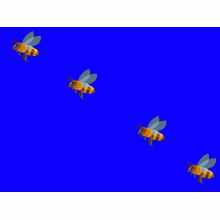
Hosted by OSOS , contributed by athzafei on 25 February 2018
- pupils' awareness on the relationship among bees and sustainability (pollinators and bee products/beekeeping)
- pupils' initiatives to take action and protect them e.g. creation of gardens friendly to bees
This project is ongoing this school year 2017-2018 on 4th Junior High School of Petroupoli, Greece. Pupils of eco group in two teams. Our school has also joined the national environmental net of Environmental Awareness Center of Arnaia, Chalkidikis and has created an eTwinning project with the italian cofounder, Mariapia Borghesan whose school also participates in OSOS project
Structure (basic subjects):
1. Bees Biology -basic facts
2. Bees Society
3. Bees Life Circle
3. Bees as Pollinators
What pollination means, plant structure and reproducive system, ways of pollunitation, insects that are pollinators
4. Bee friendly school garden-herbs planting
5. Bees and sustainability: what have we got so far in the project?

Feel
Brainstorming among students about the importance of bees in sustainability and biodiversity
Teacher presents a photo and asks why Eistein has said that?
Students know some bees products, mainly honey and wax but they encouranged to think why bees are important in ecosystems and what biodiversity and sustainability is

After discussion in groups students present their ideas and teacher clarifies the topic. Finally a working sheet only with photos is offered to students and they fill it trying to make the "connections" among photos

Students feel the importance of bees and decide to work on the subject



Imagine
Teacher asks students to imagine that they are bees and a journalist arrives at their school and takes intervies from them
Students-bees are divided in 9 groups and each group has web search so that they be able to answer in the :interview". Each team uses a shared google sheet and all students shared the same google drive.
| Students | Page |
|
a)[GR] Elpida b) [GR] Dimitra c) [IT]Gianluca d) [IT]Loris |
1. Bees Biology I-Morphology |
|
a) [GR] Evelina b) [GR] Sofia c) [IT]Emma d) [IT]Ilaria |
2. Bees Biology II-Reproduction, stages of growth |
|
a)[GR] Irene b)[GR] Natalia c) [GR] Vasia d) [IT]Giulia e)[IT]Sofia |
3. Bees Society |
|
a)[GR] Alexandra b)[GR] Niki c) [IT]Anna d)[IT]Mattia |
4. Bees Hives and Design |
|
a)[GR] Dimitris b)[GR] Eva c) [IT]Cristiano d)[IT]Eleonora |
5. Bees food-favorite suppliers |
|
a)[GR] Erikaiti b)[GR] Lito c) [GR] Marina d) [IT]Annalisa e)[IT] Safaa |
6. Bees payback to their suppliers-Pollination |
|
a)[GR] Melina b)[GR] Mary c) [IT]Irene d)[IT]Daniela |
7. Bees dance |
|
a)[GR] Renia b)[GR] Ioanna c) [IT]Luca d)[IT]Imad |
8. Bees have problems |
|
a)[GR] Marina b)[GR] Marios c) [GR] Eleftheria d) [IT]Basma d)[IT]Francesca |
9. Bees need help |
Create
Phase of insquire:
Searching info using a variety of resources (web, books, specialists -Agricultural university of Athens and Environmental Awareness Centers at Kalavryta and Arnaia Chalkidikis during our educational trips on the field) students have managed to answer the questions in the google docs and also they have create many materilas -notebooks, posters, online walls, word clouds, pieces of art, cards and an online game on kahoot)
Some photos here:




working on menti (summing up the results of web search for plants that are suitable for bees):






















